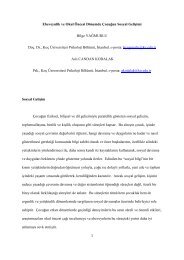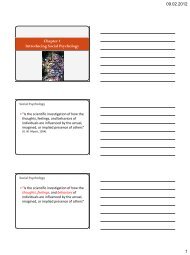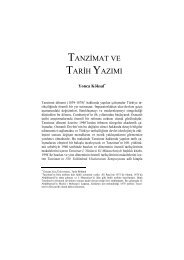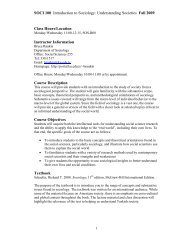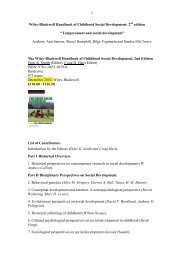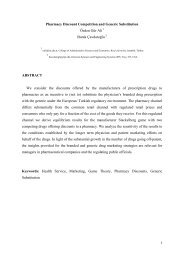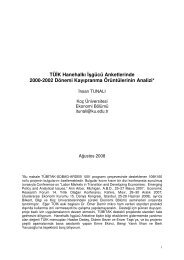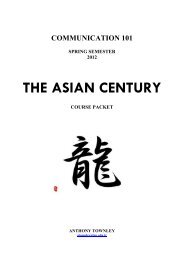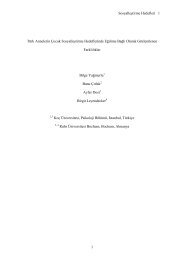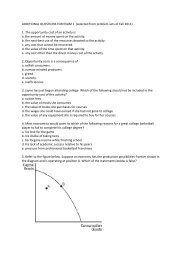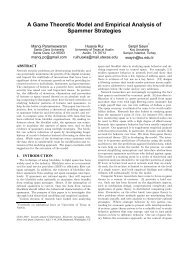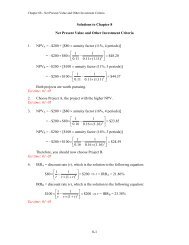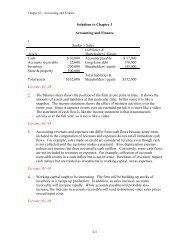The Role of Emotion Regulation in the Treatment of Child Anxiety ...
The Role of Emotion Regulation in the Treatment of Child Anxiety ...
The Role of Emotion Regulation in the Treatment of Child Anxiety ...
Create successful ePaper yourself
Turn your PDF publications into a flip-book with our unique Google optimized e-Paper software.
280 Cl<strong>in</strong> <strong>Child</strong> Fam Psychol Rev (2007) 10:275–293<br />
Cognitive Indicators<br />
It has been suggested that cognition and emotion are<br />
<strong>in</strong>tricately bound. Recent f<strong>in</strong>d<strong>in</strong>gs <strong>in</strong>dicate that <strong>the</strong> same<br />
underly<strong>in</strong>g neural mechanisms direct both emotion regulation<br />
and higher cognitive processes, such as work<strong>in</strong>g<br />
memory and susta<strong>in</strong>ed volitional attention (Bell and Wolfe<br />
2004). In fact, several studies support <strong>the</strong> notion that<br />
emotional arousal (e.g., anxiety) can impede cognitive<br />
processes such as attention and work<strong>in</strong>g memory. For<br />
example, Eisenberg et al. (2001) observed that children<br />
with <strong>in</strong>ternaliz<strong>in</strong>g disorders demonstrated low attention<br />
regulation. In ano<strong>the</strong>r study <strong>of</strong> attention allocation, socially<br />
anxious adults showed <strong>in</strong>creased self-focused attention and<br />
decreased external attention <strong>in</strong> feared social situations<br />
(Mansell et al. 2003). Also, Ladouceur et al. (2005)<br />
observed that children with comorbid anxiety and depressive<br />
disorders were significantly more distracted on a<br />
work<strong>in</strong>g memory task when presented with negative<br />
emotional stimuli compared to low-risk controls. <strong>The</strong>refore,<br />
<strong>in</strong>creased ability to regulate one’s emotions may be<br />
evident <strong>in</strong> <strong>in</strong>creased attention and work<strong>in</strong>g memory capabilities<br />
and this may be measured directly before and after<br />
treatment.<br />
Due to <strong>the</strong> <strong>in</strong>creased cognitive load dur<strong>in</strong>g emotionally<br />
arous<strong>in</strong>g events, it is possible to exam<strong>in</strong>e enhanced emotion<br />
regulation skills through experimental attention tasks.<br />
Us<strong>in</strong>g a modified Stroop Color-nam<strong>in</strong>g Task, Mat<strong>the</strong>ws<br />
and MacLeod (1985) found that anxious subjects responded<br />
slower when presented with threat related words<br />
(physical or social threat) compared to controls. <strong>The</strong>se<br />
effects have also been observed <strong>in</strong> children with anxiety<br />
disorders (e.g., Mart<strong>in</strong> et al. 1992). This suggests that<br />
slower performance on <strong>the</strong> <strong>Emotion</strong>al Stroop Task may be<br />
attributable to a loss <strong>in</strong> <strong>in</strong>formation process<strong>in</strong>g capacity due<br />
to emotional arousal. <strong>The</strong>refore, <strong>in</strong>creased emotion regulation<br />
skills should lead to <strong>in</strong>creased <strong>in</strong>formation process<strong>in</strong>g<br />
capacity after successful <strong>the</strong>rapy. F<strong>in</strong>ally, self-report<br />
measures <strong>of</strong> emotion regulation skills have been utilized<br />
frequently with children. Assessment <strong>in</strong>struments such as<br />
<strong>the</strong> <strong>Child</strong>ren’s <strong>Emotion</strong> Management Scales (Zeman et al.<br />
2001; Suveg and Zeman 2004) and <strong>the</strong> <strong>Emotion</strong> <strong>Regulation</strong><br />
Interview (Suveg and Zeman 2004) may <strong>of</strong>fer additional<br />
<strong>in</strong>sights <strong>in</strong>to children’s perceptions <strong>of</strong> <strong>the</strong>ir ability to regulate<br />
<strong>the</strong>ir own emotions.<br />
Behavioral Indicators<br />
Developmental psychologists have devised various methods<br />
to measure emotion regulation through specific<br />
behavioral observation systems. For example, by observ<strong>in</strong>g<br />
facial and vocal responses to emotionally arous<strong>in</strong>g events it<br />
is possible to measure <strong>the</strong> latency, persistence, recovery<br />
time, and <strong>in</strong>tensity <strong>of</strong> an emotional reaction (Thompson<br />
1994).<br />
Although <strong>in</strong>itially designed for young children, <strong>the</strong><br />
“disappo<strong>in</strong>tment task” (Cole et al. 1994) can <strong>of</strong>fer valuable<br />
<strong>in</strong>sights <strong>in</strong>to children’s behavioral regulation <strong>in</strong> response to<br />
negative emotions at any age. In this task, <strong>the</strong> child is asked<br />
to rank-order prizes and <strong>the</strong>n is led to believe she will<br />
receive her preferred toy. When given <strong>the</strong> least preferred<br />
toy, <strong>the</strong> child’s emotional reactions can be coded. Various<br />
affective behaviors (e.g., anger, sadness, worry, smil<strong>in</strong>g,<br />
etc.) and self-regulatory behaviors (active, passive, and<br />
smil<strong>in</strong>g) can be reliably coded dur<strong>in</strong>g this task (e.g., Forbes<br />
et al. 2006). If direct behavioral observations are not feasible,<br />
parent reports <strong>of</strong> <strong>the</strong>ir children’s emotion regulation<br />
skills can be obta<strong>in</strong>ed us<strong>in</strong>g <strong>the</strong> <strong>Emotion</strong> <strong>Regulation</strong><br />
Checklist (Shields and Cicchetti 1997).<br />
<strong>Anxiety</strong> <strong>in</strong> <strong>Child</strong>hood<br />
It also appears to be <strong>the</strong> case that anxious children<br />
may display biases <strong>in</strong> <strong>the</strong> ways <strong>the</strong>y anticipate <strong>the</strong><br />
future, cope with <strong>the</strong> present and remember <strong>the</strong> past.<br />
(Vasey and MacLeod 2001, p. 256)<br />
When discuss<strong>in</strong>g poor emotion regulation skills among<br />
anxious children, it is necessary to exam<strong>in</strong>e <strong>the</strong> basic<br />
symptomatology <strong>of</strong> anxiety and how emotion regulation is<br />
<strong>in</strong>tertw<strong>in</strong>ed with <strong>the</strong> anxiety disorders. <strong>The</strong> follow<strong>in</strong>g<br />
section provides a brief overview <strong>of</strong> how poor emotion<br />
regulation could be a core feature <strong>in</strong> develop<strong>in</strong>g and<br />
ma<strong>in</strong>ta<strong>in</strong><strong>in</strong>g anxiety and how it can impede function<strong>in</strong>g<br />
when <strong>the</strong> child is not able to adjust her emotional state<br />
accord<strong>in</strong>g to <strong>the</strong> situation.<br />
<strong>Anxiety</strong> disorders are among <strong>the</strong> most prevalent problems<br />
<strong>in</strong> childhood and adolescence (Anderson et al. 1987).<br />
Some common symptoms <strong>of</strong> anxiety <strong>in</strong>clude <strong>in</strong>trusive and<br />
catastrophic thoughts, uncontrollable worry, avoidance<br />
behavior, and <strong>in</strong>creased activation <strong>of</strong> <strong>the</strong> sympa<strong>the</strong>tic nervous<br />
system (e.g., <strong>in</strong>creased heart rate, sweat<strong>in</strong>g, shortness<br />
<strong>of</strong> breath). <strong>The</strong> presence <strong>of</strong> an anxiety disorder can lead to<br />
considerable distress and <strong>in</strong>terference for children and <strong>the</strong>ir<br />
families. For <strong>in</strong>stance, <strong>the</strong> avoidance <strong>of</strong> certa<strong>in</strong> social<br />
activities can impede normal social development and even<br />
lead to peer rejection (Ollendick and Hirshfeld-Becker<br />
2002; Strauss et al. 1987). Be<strong>in</strong>g consumed with uncontrollable<br />
worry and anxiety can also lead to attention<br />
problems (Kendall and Pimentel 2003), low self-esteem<br />
(Mash and Wolfe 2002), and poor academic achievement<br />
(Ialongo et al. 1995).<br />
In this section, we provide brief descriptions <strong>of</strong> two<br />
anxiety disorders, social anxiety disorder and panic<br />
123



